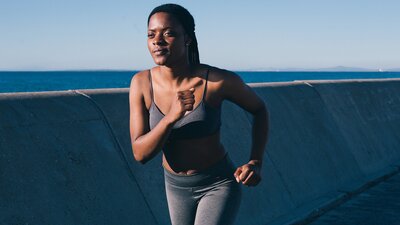It’s that time of year again where runners are back outside putting in those miles. What some don’t realize is the importance of strength training in their running programs. Strength training has been shown to increase running performance and reduce the likelihood of injury (6, 2, 3).
If you are a runner looking for strength exercises to add to your program, here are four practical strength exercises tailored to enhance your running performance and minimize the risk of injuries. Whether you're a seasoned marathoner or just starting your running journey, incorporating these exercises can significantly benefit your overall performance and endurance.
Programming Variables
A list of exercises is helpful; however, it’s crucial to program them into a training cycle at the appropriate volume and intensity. Several systematic reviews and meta-analyses successfully used the following programming variables (6, 2).
2-3 strength training sessions per week
2-4 lower body strength exercises per session
Low to high training intensity (40%-80% 1RM)
Low to moderate volumes
Most exercises in the research were machines, squats, or deadlifts. However, these may not be specific enough to the functional demands of running. The principle of specificity states that training should mimic the movements of the particular activity as closely as possible for the body to adapt appropriately (2a).
Running is a closed-chain, weight-bearing exercise. Therefore, training that does not incorporate similar mechanics replicating the running movement may not alter running kinematics and kinetics. (2a). For this reason, exercises for runners should be closed-chain (The body moves around the working limb; think deadlift versus seated hamstring curl), weight-bearing, or similar to running movements.
Single Leg Romanian Deadlift
The single-leg RDL meets the criteria for a top-tier runner strength exercise. It is closed-chain, the ascent replicates the leg's swing, and it is weight-bearing. In addition, it is unilateral, which focuses on stabilizing the weight-bearing hip and ankle in the frontal plane of motion. The single-leg RDL will work the ankle muscles, hamstring, gluteus medius, gluteus maximus, and more. These are crucial for improving running performance and injury reduction (4).
Split Squat Heels Up
The “heels up” may make some readers curious about its effects on running performance. According to research, many running injury prevention programs focus only on strengthening the hips (2a). Stronger ankle and foot muscles can reduce injuries by improving force distribution.
The majority of ankle joint strength training protocols in research articles utilize variations of calf raises. However, it may be worthwhile to consider maintaining an elevated heel during compound lower body exercises like the split squat as an alternative method for calf raises. This approach may offer comparable benefits to traditional calf raise exercises while saving time.
It has been found that weak plantar flexor (foot and ankle) strength is associated with an increased incidence of Achilles tendinopathy, one of the most common overuse running injuries (2a).
The split squat is a unilateral squat pattern that emulates the leg’s stride and is closed-chain and weight-bearing. Don’t be afraid to substitute a barbell back squat with a heels-up split squat variation. Research shows that split squats can elicit greater hip extensor muscle activation than back squats at the relative intensity of loads (1).
Step Down/Up
The step-down, or step-up, demands high amounts of hip, knee, and ankle stability in the frontal plane and massive amounts of activation of the gluteus medius (8). It has practical applications to a runner’s strength training program as a unilateral, weight-bearing, closed-chain exercise.
We call this exercise the “step down” to emphasize the stability of the eccentric or downward phase. Doing so increases the time under tension and creates more opportunities to increase motor control and stability.
Single Leg Foam Roller Hamstring Curls
Many studies on the effects of strength training on running performance only use hamstring machine curls for training hamstrings (5, 7, 9). There are arguably better exercise selections for runners. The single-leg foam roller hamstring curl is open-chain, weight-bearing, works the calf and gluteal muscles, and trains stability in the hip in the transverse plane of motion (prevents hip rotation).
Furthermore, the foot and ankle are trained in isometric plantar flexion, which should have a beneficial carryover to reduce the likelihood of injury in the foot, ankle, and calf. To train for this exercise, follow the following cues:
Place the heel on the roller with the knee extended
Bridge the hips and roll the roller towards your hips while keeping the hips elevated
The point of contact on the foam roller goes from the heel to the toes throughout the exercise
Sources
Arakawa H, Mori M, Tanimoto M. Greater Hip Moments in Rear-Foot-Elevated Split Squats Than in Conventional Back Squats With the Same Relative Intensity of Loads. J Strength Cond Res. 2023 May 1;37(5):1009-1016. doi: 10.1519/JSC.0000000000004351. Epub 2022 Dec 14. PMID: 36542838.
Balsalobre-Fernández C, Santos-Concejero J, Grivas GV. Effects of Strength Training on Running Economy in Highly Trained Runners: A Systematic Review With Meta-Analysis of Controlled Trials. J Strength Cond Res. 2016 Aug;30(8):2361-8. doi: 10.1519/JSC.0000000000001316. PMID: 26694507.
Baltich J, Emery CA, Stefanyshyn D, Nigg BM. The effects of isolated ankle strengthening and functional balance training on strength, running mechanics, postural control and injury prevention in novice runners: design of a randomized controlled trial. BMC Musculoskelet Disord. 2014 Dec 4;15:407. doi: 10.1186/1471-2474-15-407. PMID: 25471989; PMCID: PMC4295291.
Blagrove RC, Howatson G, Hayes PR. Effects of Strength Training on the Physiological Determinants of Middle- and Long-Distance Running Performance: A Systematic Review. Sports Med. 2018 May;48(5):1117-1149. doi: 10.1007/s40279-017-0835-7. PMID: 29249083; PMCID: PMC5889786.
Collings TJ, Bourne MN, Barrett RS, Meinders E, GONçALVES BAM, Shield AJ, Diamond LE. Gluteal Muscle Forces during Hip-Focused Injury Prevention and Rehabilitation Exercises. Med Sci Sports Exerc. 2023 Apr 1;55(4):650-660. doi: 10.1249/MSS.0000000000003091. PMID: 36918403.
Kelly, Cherina M1; Burnett, Angus F1,2; Newton, Michael J1. The Effect of Strength Training on Three-Kilometer Performance in Recreational Women Endurance Runners. Journal of Strength and Conditioning Research 22(2):p 396-403, March 2008. | DOI: 10.1519/JSC.0b013e318163534a
Llanos-Lagos C, Ramirez-Campillo R, Moran J, Sáez de Villarreal E. Effect of Strength Training Programs in Middle- and Long-Distance Runners' Economy at Different Running Speeds: A Systematic Review with Meta-analysis. Sports Med. 2024 Jan 2. doi: 10.1007/s40279-023-01978-y. Epub ahead of print. PMID: 38165636.
MILLET, GREGOIRE P.; JAOUEN, BERNARD; BORRANI, FABIO; CANDAU, ROBIN. Effects of concurrent endurance and strength training on running economy and V̇O2 kinetics. Medicine & Science in Sports & Exercise 34(8):p 1351-1359, August 2002.
Moore D, Semciw AI, Pizzari T. A SYSTEMATIC REVIEW AND META-ANALYSIS OF COMMON THERAPEUTIC EXERCISES THAT GENERATE HIGHEST MUSCLE ACTIVITY IN THE GLUTEUS MEDIUS AND GLUTEUS MINIMUS SEGMENTS. Int J Sports Phys Ther. 2020 Dec;15(6):856-881. doi: 10.26603/ijspt20200856. PMID: 33344003; PMCID: PMC7727410.
Sedano, Silvia1; Marín, Pedro J.1,2; Cuadrado, Gonzalo3; Redondo, Juan C.3. Concurrent Training in Elite Male Runners: The Influence of Strength Versus Muscular Endurance Training on Performance Outcomes. Journal of Strength and Conditioning Research 27(9):p 2433-2443, September 2013. | DOI: 10.1519/JSC.0b013e318280cc26

